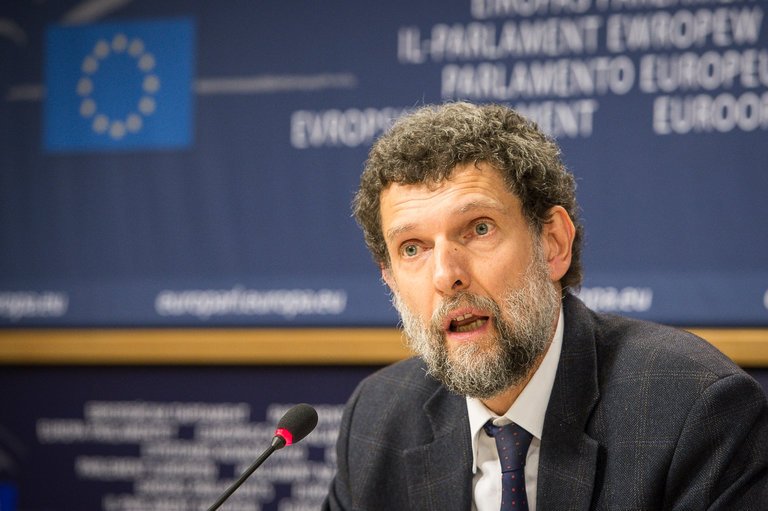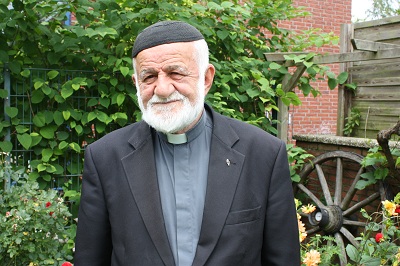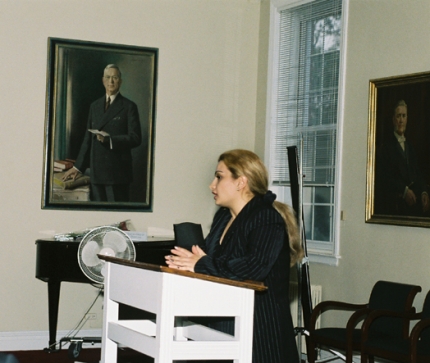I am in a town in Germany near the border with Holland called Gronau. For years I have conducted interviews with the elderly. If I am not mistaken, today, I am interviewing the sixty-fifth person. I have interviewed an Assyrian clergyman of the Syriac Orthodox Church, Reverend Lahdo Kahya, five times previously. Today I came here to interview him on a slightly different subject.
As I arrived, the priest’s wife started talking immediately, “When we were in the old country it was never like this. We knew when it was winter or when it was summer. Here everything is mixed up. Look what rain and wind did to my flowers in the garden.”
I looked at the garden for a second. It is worth glancing at. It’s a well-cared-for garden which has colorful flowers. But upon closer inspection, the roots are weak and easily breakable. I tried readjusting some of them into place, but alas it was not possible. Wind took half of the flowers and carried them off into the distance. Reverend Lahdo came closer to me, feeling regretful.
“I would give the ten years that I have lived in this place for one day in my country. It seems like we have been here for years. I wish this never happened and we did not have to come here like wild birds,” he lamented.
A voice was heard from inside, “The coffee is ready.”
We go inside and while sipping on our coffee I set up the video camera that I brought with me.
Then, I press the record button.
The priest informs, “Today, I will be telling you about a page from my life. I will tell you about the 16 years I lived in Adiyaman.”
“Life is full of coincidences. I, being a pastor, am also one of the coincidences. The year is 1968 and none of my family members know that I am going to be a priest because I made my decision on my own without consulting them. After mentioning my decision to Metropolitan Mor Hanna Dolabani, I realize that there is no way back. After that, my relatives who heard this news were surprised. However, the decision has been made and there was nothing left to do but for them to simply congratulate me.
“There was the need for a priest in Adiyaman. There were the Orthodox churches of St. Peter and St Paul. In a very short time I found myself in Adiyaman with my family. Here, there were a total of 60 Christian families. From the 60, 40 of them were Armenian and the rest were Assyrian. I served these people for 16 years without any discrimination. I am not supposed to discriminate, because these two nationalities were not discriminating against each other here. The best time I had in my life was here, with these people. These people were full of melancholy. In 1915 there were 700 Armenian and 100 Assyrian families living in Adiyaman. They were living happily. They were the crafters of this place.
Turks, Assyrians, Armenians and Alevis were living together as one, like flowers in a garden. The migration of Turks to this area happened much later. The Armenian cemetery that is 1600 year old is a witness to this. In this cemetery are buried not only Armenians but also Assyrians. There are no other nationalities in the world that share there sadness and there happiness together like Armenians and Assyrians in Adiyaman. Think about it, they lived together and they were buried at the same cemetery. With no doubt, the common sadness that was recently shared between them brought these two nationalities much closer to each other. Armenians and Assyrians used to marry each other and both sides would speak in Armenian. Many Assyrians had Armenian names. As you see, I served as a priest in a place like this. How could I have discriminated between these two peoples?
“Survivors from 1915 happened to have survived by hiding in Alevi houses in small villages close by. They went through much pain. Some mothers and fathers left their children there for short term periods. However, many never came back retrieve their children; they were just not able to. After many years passed, the children that were left in the villages returned to the city in Adiyaman. There were villages like Kahta, Narinca, Ulbis, Kafardis, Gerger, Venk, Haspiyas and many more. The Muslims in these villages used to come to me secretly. Among these people there are some that I remember like it was yesterday, for example, Ali, Mehmet, Mustafa, Osman and more. They all used to come and tell me their sad stories and what they went through. All of these people were Armenian. All of them were Christians. Yes, they were Muslim in the morning and Christian at night.
“I mentioned it a few minutes ago. Back then, people who used to be crafters were usually Armenian or Assyrian. Very few of these people were able to survive the genocide because of their talents.
“I cannot remember its original name but it was right in the middle of the city, an Armenian monastery, called Merdivenli Kilise (Church with Stairs). It is still there. However, they did not leave any survivors to go to the monastery. They destroyed them all. Along with sweeping everyone, they destroyed their churches too. One day someone came to me saying they wanted to build a big house on a flat territory and showed me some stones that he found from that land which had Armenian writing on it. I went to check it and realized that once there was an Armenian church here. Now they have built a castle atop of that land. However, Armenians do not live in this castle, others do.
“It has been argued that Armenians were temporarily going to migrate but this is not true. Because in 1915, 300 Balkan fugitive families came to live a week later instead of Armenians and Assyrians who were supposed to migrate. Everything was planned out. Fugitives who migrated seized a great number of goods and properties in a very short time. Today, these people are known as the fugitives in Adiyaman. For example, there was a fugitive Kerem around this area.
“I lived here from 1968 till 1985. Later I moved to Germany with my family because of the way Turkey’s situation was going and also because of the increasing number of threats I was receiving.”
“Why were you being threatened?” I asked.
“You know, the church I was serving in was also being used as a therapy center. The number of people who pretended to be Muslim in the morning and Christian at night was not little in this area and lives of these people were full of dramas. They used to come to me to tell me about their sad stories and used to pray. Among these people there was an elderly woman named Emine, may she rest in peace. Emine was the nicest person in the world. Every year she would come from Malatya to Adiyaman to visit her married daughter. She used to stay here for two weeks. Every time she came, she would tell a lie to her daughter and her uncle saying that she is going to the bazaar to buy candy for the children. But she would just come to our church. She would apologize to us and would ask to be left alone for a moment. Then she would kneel down in the middle of the church and would cry as loud as she could. We used to listen to her exclamation from far away. God forbid others live the pain of what Emine was going through. We would have cried with her too. Our hearts would also break into pieces with her. Emine used to hide her real name, Ani, and hide her long life-story about the way she was lying to her daughter and uncle and coming to the church.
“The individuals who used to also come to us were named Ali, Osman, Mustafa and Haci amongst others. Their real names though were Markus, Hayganus, Sarkis, Artin and Barsawmo.
“They would come from Malatya, Maras, Urfa and Antep. Here they used to pray and to share their memories and stories. They were all sad memories; ones that were very heavy for a person to carry. So heavy that their hearts were not able to bare the pain. I used to baptize these people one by one, group by group. I remember just in one night I baptized 72 people non-stop.
“Of course, the things done by me were heard about. I was receiving threatening letters and the number of threats was increasing. Some officers with good intentions would warn me to be careful. There were really nice officers around too. I was not scared. However I had children growing up at the time and I was getting scared for them. On top of this I left the city that I loved the most, Adiyaman and moved to Germany.
“In 16 years of my life in Adiyaman, I had baptized total of 742 people who were Muslim in the morning and Christian at night. Most of these people were Armenian. They had lives based on lies. The ones who were Muslim and went to the mosque even though they did not want to.
“Later in time, they also began to move to Germany like us. Some live in Koln and Bochult which is close by. Armenians who live here are now Christian day and night. I still go to Bochult and serve them as a religious man.
“I know saying it is easy but let me tell you this: there could have been 742 novels written and 742 films made with the stories of these people. My God, why all this pain? I still cannot believe it. Why destroy the lives of so many people? Why make so many people go through so much pain? That country would have been enough for all of us. That city was the world’s most beautiful city and that geography was the world’s most beautiful geography. And today, all we have left there is one cemetery.”
By Sabri Atman



